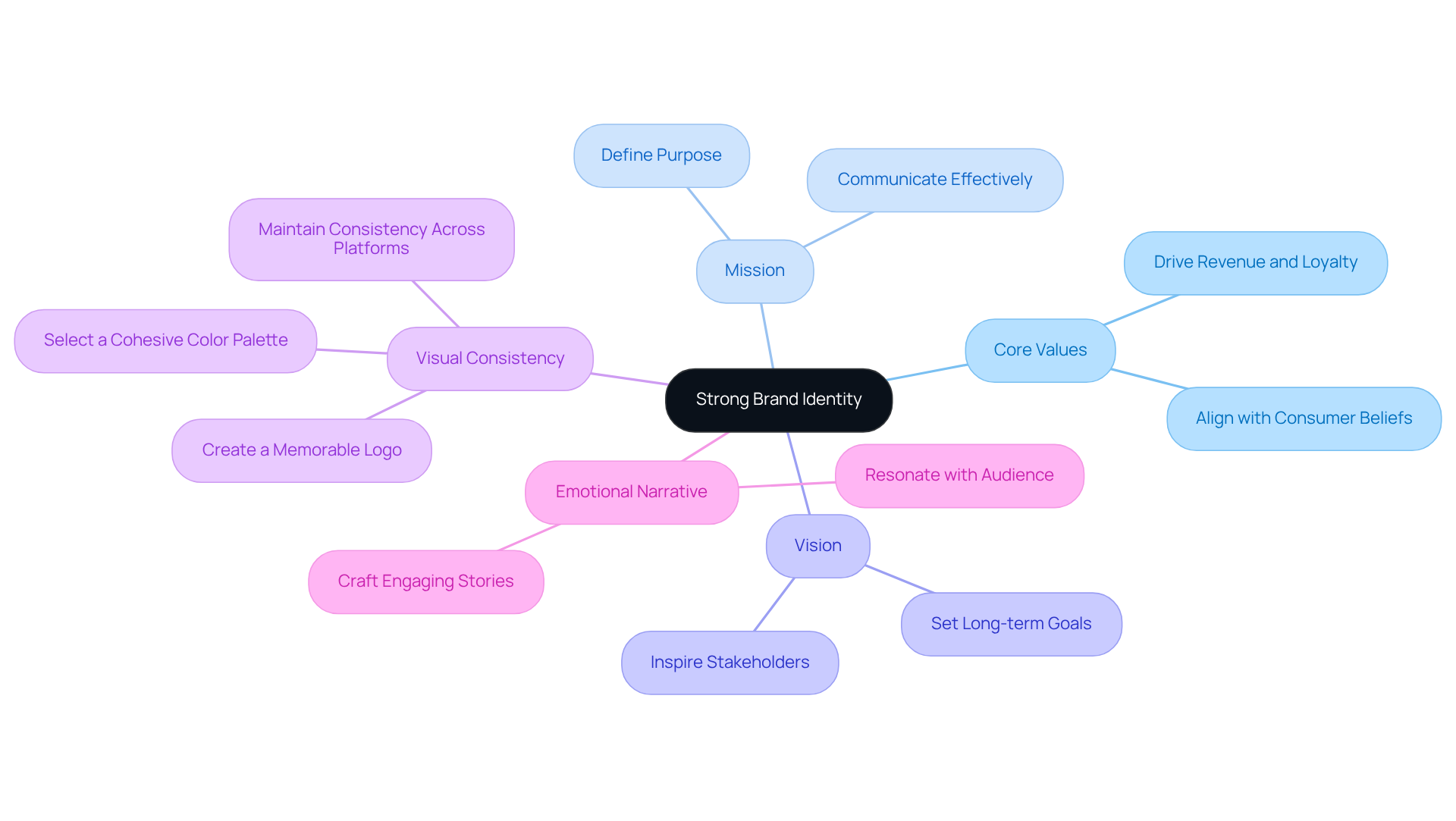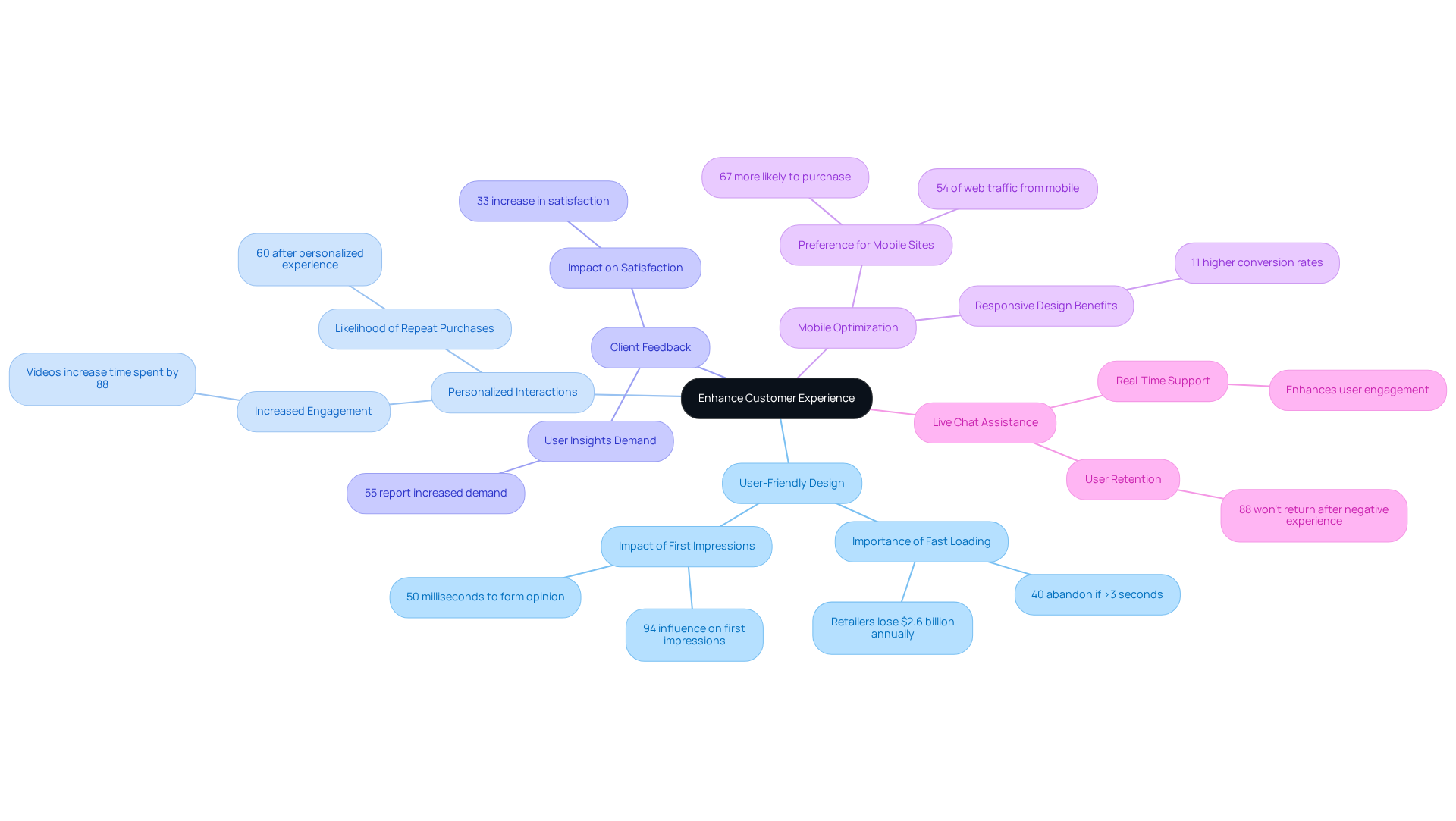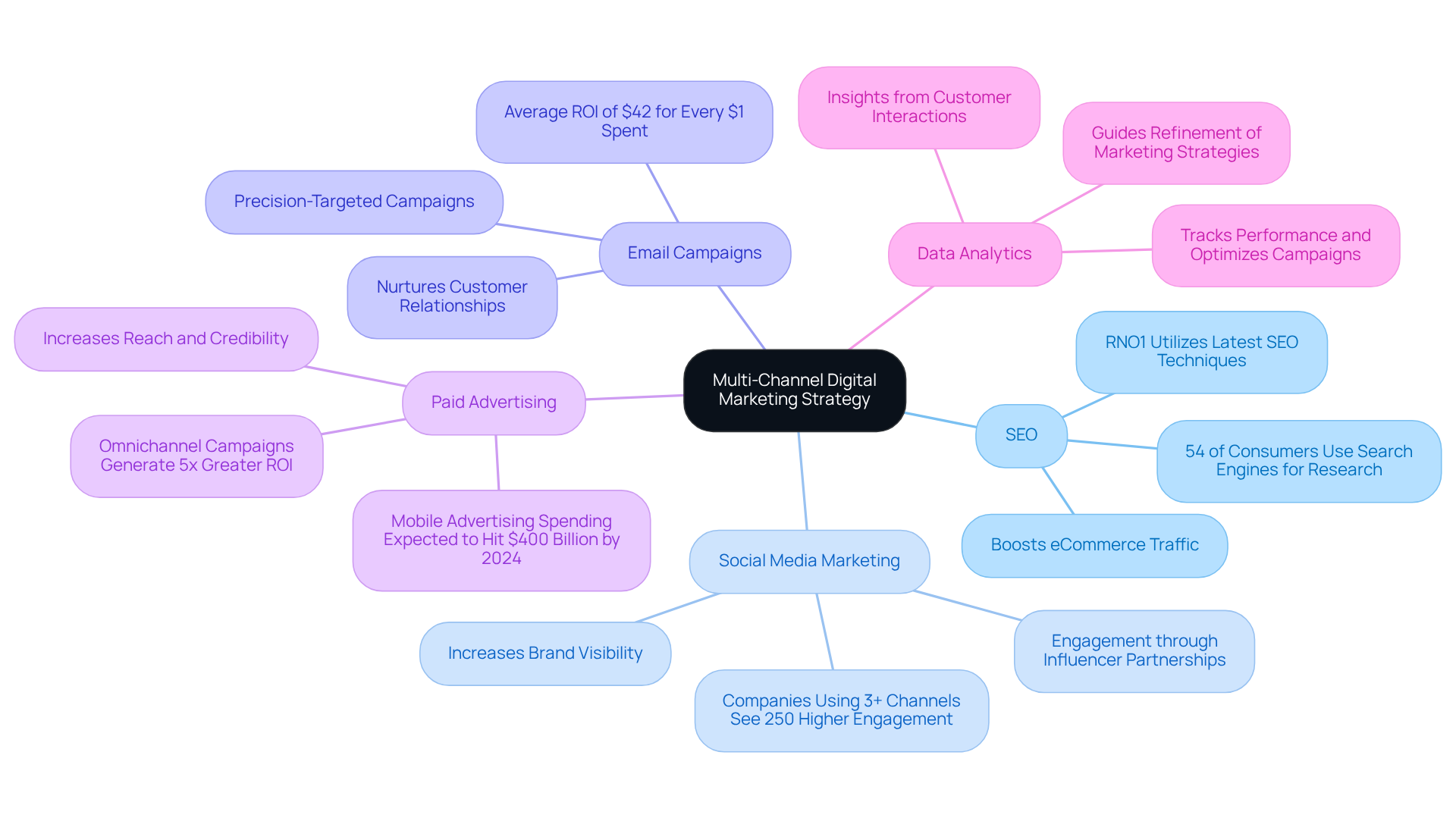Overview
In the world of e-commerce, many entrepreneurs face the challenge of standing out in a crowded market. This struggle can lead to feelings of frustration and uncertainty. However, there are effective practices that can help navigate this complex landscape. The article highlights four key strategies for establishing a successful brand:
- Creating a strong brand identity that resonates with your audience.
- Enhancing the customer experience to foster loyalty.
- Implementing effective digital marketing strategies that reach your target market.
- Utilizing data-driven insights to inform your decisions.
Each of these practices is backed by compelling evidence that underscores their importance. For instance, consistency in branding is crucial for recognition, helping customers remember and trust your brand. Personalized experiences can significantly boost customer satisfaction, making them feel valued and understood. Multi-channel marketing has proven to be effective in reaching customers where they are, while analytics provide invaluable insights into consumer behavior, guiding your branding efforts.
By embracing these strategies, you can build a successful e-commerce brand that not only meets the needs of your customers but also nurtures a lasting connection with them. Remember, the journey of branding is not just about selling products; it's about creating a community where your customers feel seen and appreciated.
Introduction
In the competitive landscape of e-commerce, establishing a powerful brand identity is not just important; it's essential. Businesses are constantly vying for consumer attention, often feeling lost in a sea of options. This struggle can lead to frustration and uncertainty, as many wonder how they can truly stand out and connect with their audience. By enhancing customer experience, implementing effective digital marketing strategies, and leveraging data-driven insights, brands can not only rise above the noise but also cultivate meaningful relationships with their customers.
Yet, the challenge persists: how can businesses effectively weave these elements together to create a cohesive and impactful branding strategy that resonates with consumers in 2025 and beyond? This is where we can step in to support you. By focusing on nurturing your brand's identity and understanding the emotional needs of your audience, we can help you craft a strategy that not only captures attention but also fosters loyalty and trust. Together, we can navigate this complex landscape and ensure your brand shines brightly.
Establish a Strong Brand Identity
Establishing a strong identity for your business can feel overwhelming. Many founders struggle to clearly define their core values, mission, and vision, which are essential for branding e commerce and building a lasting brand. It's vital to create a memorable logo and select a color palette that truly reflects your identity's personality. Consistency across all platforms—like your website, social media, and packaging—is essential for branding e commerce and fostering loyalty among clients.
Take Glossier, for example. They have successfully established a strong identity by maintaining a unified aesthetic and voice throughout all customer interactions. This consistency has significantly enhanced their recognition and loyalty. In fact, utilizing a consistent color scheme can boost brand recognition by an impressive 80%. Imagine how much easier it would be for your audience to remember you if you could achieve that level of recognition!
Moreover, crafting an engaging narrative that resonates emotionally with your audience can enhance your branding e commerce efforts by improving relatability and memorability, allowing your identity to shine in a competitive market. As marketing specialists emphasize, 'Core values drive revenue, attract potential sales, and provide a competitive edge to companies.' Aligning your values with consumer beliefs is essential for branding e commerce and nurturing enduring relationships.
Remember, it takes 5 to 7 impressions to create brand awareness. This underscores the importance of to your branding e commerce messaging. By focusing on these key elements, you can cultivate a strong identity that not only stands out but also fosters a genuine connection with your audience.

Enhance Customer Experience
To truly enhance user satisfaction, it’s essential to focus on creating a user-friendly website design and intuitive navigation. Many users struggle with complex websites, leading to frustration and disengagement. By incorporating key features such as personalized product recommendations and streamlined checkout processes, we can significantly improve user experiences. For instance, did you know that 60% of consumers are likely to become repeat buyers after a customized purchasing encounter? This statistic underscores the importance of fostering personalized interactions that resonate with users.
When businesses prioritize , they often see a remarkable 33% increase in client satisfaction. This improvement not only reflects better client relations but also contributes to a nurturing environment where users feel valued. Listening to client feedback is vital for ongoing enhancement; Amazon exemplifies this by effectively leveraging client reviews and ratings, which not only provide social proof but also enrich the overall shopping experience.
Organizations that adopt advanced research practices are 1.9 times more likely to report enhanced client satisfaction. This illustrates just how powerful user feedback can be in shaping positive outcomes. Moreover, incorporating live chat assistance can address inquiries in real-time, fostering a responsive and engaging shopping atmosphere. As we know, 88% of online users are less likely to return to a website after a negative experience, and 86% of consumers will leave a reliable company after just two unfavorable interactions. This highlights the necessity of ensuring a seamless user journey to retain clients and boost sales.
Additionally, with 67% of mobile users being more inclined to purchase from a mobile-friendly site, optimizing for mobile is crucial in today’s digital landscape. Let’s work together to create an environment where every user feels supported and valued, paving the way for lasting relationships and success.

Implement Effective Digital Marketing Strategies
In today's fast-paced digital landscape, many businesses struggle to connect with their customers effectively. This challenge can lead to missed opportunities and a sense of disconnect. As a solution, implementing a multi-channel digital marketing strategy can be a nurturing way to engage your audience. By incorporating the following elements, you can create a holistic approach that truly resonates with your customers:
- SEO
- Social media marketing
- Email campaigns
- Paid advertising
Data analytics plays a crucial role in this process, allowing you to track performance and optimize your campaigns. For example, companies like Warby Parker have successfully utilized social media to forge connections with their customers, resulting in increased website visits. Imagine the impact of influencer partnerships as well; they can significantly expand your reach and enhance your credibility.
It's essential to tailor your messaging so that it aligns with your brand identity and speaks directly to your audience's needs. With 54% of consumers expected to utilize search engines for product research in 2025, a can profoundly influence eCommerce traffic, ultimately boosting conversions and improving visibility.
According to industry expert Dina Essawy, "Email continues to be a top-performing channel in multi-channel marketing approaches, with an average ROI of $42 for every $1 spent." By weaving these elements together, businesses can develop a cohesive and effective branding eCommerce strategy that addresses the demands of today's digital world. Moreover, companies that employ three or more channels in their marketing strategies experience, on average, a 250% higher engagement rate. This statistic highlights the effectiveness of a multi-channel approach, reassuring you that you're not alone in this journey—many have found success through these methods, and you can too.

Utilize Data-Driven Insights for Branding
Understanding , preferences, and purchasing patterns is a challenge many tech startup founders face. This can leave you feeling uncertain about how to connect meaningfully with your customers. But don’t worry; there’s a way to turn this around. By utilizing analytics tools, you can gather valuable insights that guide your branding e commerce strategies and marketing efforts, allowing for more personalized interactions with your clients.
For example, eCommerce platforms like Shopify provide built-in analytics that help businesses track customer engagement and sales trends. Imagine being able to refine your product offerings and optimize your pricing strategies based on real data. This not only enhances your marketing messages but also strengthens your connection with your audience.
Additionally, consider the power of A/B testing different elements in branding e commerce. This approach can reveal what truly resonates with your audience, helping you to foster deeper relationships. Remember, you’re not alone in this journey; many have navigated similar paths and found success through understanding their customers better. Embrace these tools and strategies, and you’ll be well on your way to creating a more compassionate and effective brand.

Conclusion
Establishing a powerful branding strategy in e-commerce can feel overwhelming for businesses striving to thrive in a competitive landscape. Many may struggle with how to create a strong brand identity that resonates with customers, enhance their experiences, and implement effective digital marketing strategies. This challenge can lead to frustration and uncertainty. However, by focusing on these key areas—developing a compelling brand identity, enhancing customer experiences, utilizing effective digital marketing strategies, and leveraging data-driven insights—brands can foster loyalty and drive growth. These practices not only help in building recognition but also in cultivating meaningful relationships with customers.
Throughout this article, we have highlighted the importance of consistency in brand identity, the necessity of user-friendly experiences, the benefits of multi-channel marketing, and the transformative power of data analytics. For instance, a cohesive brand identity can significantly boost recognition, while personalized customer interactions can lead to increased satisfaction and repeat purchases. Imagine the joy of receiving tailored recommendations that truly meet your needs. Furthermore, effectively leveraging digital marketing channels and using analytics tools can provide invaluable insights that refine strategies and enhance engagement.
Ultimately, embracing these practices is not merely about survival in the e-commerce arena; it’s about thriving and creating lasting connections with customers. Businesses that prioritize branding and customer experience will not only stand out but also foster loyalty that drives long-term success. As the digital landscape continues to evolve, adapting these strategies will be vital for any brand looking to make a significant impact. Together, we can navigate this journey, ensuring that your brand not only survives but flourishes in the ever-changing e-commerce environment.
Frequently Asked Questions
Why is establishing a strong brand identity important for a business?
A strong brand identity helps define core values, mission, and vision, which are essential for building a lasting brand and fostering client loyalty.
What are the key components of a strong brand identity?
Key components include a memorable logo, a well-selected color palette, and consistency across all platforms such as websites, social media, and packaging.
How does consistency in branding affect recognition?
Consistency in branding can significantly enhance recognition, with studies showing that a consistent color scheme can boost brand recognition by up to 80%.
Can you provide an example of a brand with a strong identity?
Glossier is an example of a brand that has successfully established a strong identity by maintaining a unified aesthetic and voice across all customer interactions.
How can storytelling enhance branding efforts?
Crafting an engaging narrative that resonates emotionally with the audience improves relatability and memorability, helping the brand stand out in a competitive market.
What role do core values play in branding?
Core values drive revenue, attract potential sales, and provide a competitive edge, making it essential to align them with consumer beliefs for nurturing enduring relationships.
How many impressions are needed to create brand awareness?
It typically takes 5 to 7 impressions to create brand awareness, highlighting the importance of consistent exposure to branding messaging.




